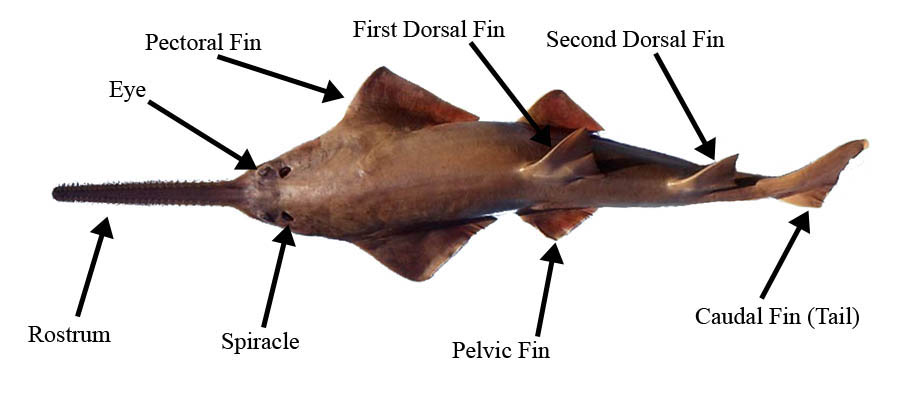Lesson: What is a Sawfish?
Lesson Summary:
This lesson examines what a sawfish is, who its close relatives are, and the form and function of its anatomy.
Vocabulary:
Elasmobranch, dorsal, pelvic, pectoral, caudal, spiracle, rostrum
Background Information:
Sawfish belong to a group of fishes called elasmobranches that include sharks, rays, skates, and sawfish. Sawfish possess a characteristic long, flattened, toothed rostrum (often referred to as the “saw”), a flattened head and trunk, along with a shark-like appearance and manner of swimming. Sawfish belong to the ray family even though they look more like sharks than rays. Sawfish should not be confused with the Sawsharks which are members of a different family (Pristiophoriformes).
Materials:
Teacher’s guide to activity
Copies of blank activity sheet
Blank paper for drawing a sawfish
Pencils (colored pencils recommended)
Procedure:
The activity begins by getting students to think about what other animals the sawfish looks similar to. Have the students begin this activity by drawing what they think a sawfish looks like, afterwards show the class some photos of sawfish along with sharks, rays, and skates, following up with discussion questions. After the discussion, handout the sawfish anatomy activity sheets and complete lesson with a discussion of the fins and other anatomical features and what the purpose of each is.
Discussion Questions:
* Where do sawfish live?
* What other fish appear similar in shape and appearance to the sawfish?
* Does the sawfish have close relatives? If so, who are these relatives?
* What makes the sawfish a unique animal?
Extension Activities:
Upon completion of the sawfish anatomy activity, discuss with students the purpose of each of these anatomical features and why each is an important adaptation in their natural habitats (rostrum – feeding, fins – swimming, eyes – vision, spiracles/gills – respiration). Also have the students try drawing a sawfish again using their newly acquired knowledge learned during this teaching activity.
Sawfish Anatomy:

Rostrum – The rostrum is what gives the sawfish its common name. It is made of cartilage and is long and flat. The teeth along the side margins of the rostrum are not really teeth but rather modified scales. Different species of sawfish have rostrums and rostral teeth of different shapes and sizes. This anatomical feature is used during feeding and for defense. The rostrum is slashed in a side-to-side motion to dislodge invertebrates from the substrate and to stun schooling fishes. In addition, the sawfish can use its rostrum in defense against large predators such as sharks.
Eyes – The eyes are located near the top of the head, allowing the sawfish to see even when partially buried. Although the eyesight of sawfish is good, the waters where sawfish reside are often murky. This unique fish relies on other senses to help locate prey.
Spiracles – The spiracles are just posterior to the eyes. They are used to circulate water through the gills during times of inactivity for respiration.
Pectoral Fins – The pectoral fins are used for lift and steering during swimming. There are two pectoral fins, each located along the sides of the sawfish, just behind the head. They consist of fan-shaped cartilage not quite extending to the margins. There is very little fat and muscle inside each fin.
Dorsal Fins – Sawfish have two dorsal fins which aid in stabilization. The term “dorsal” refers to the back or upper surface, giving rise to the name of these fins.
Pelvic Fins – The pelvic fins are also used for stabilization. Appendages at the base of pelvic fins on male specimens are referred to as claspers. Claspers are male reproductive organs.
Caudal Fin – The caudal fin, also referred to as the tail, is used to propel the sawfish forward during swimming
Activity sheet info:
Sawfish are magnificent and unique aquatic animals!
Today you will learn what a sawfish is and its anatomical adaptations for living in its natural habitat.
Background Information:
Sawfish are closely related to other fish which share many characteristics. In addition, sawfish have one anatomical feature that makes them unique in the animal kingdom – the toothed rostrum. This unique anatomical feature serves important functions.
Key Questions:
*What other fish appear similar in shape and appearance to the sawfish?
*Does the sawfish have close relatives? If so, who are these relatives?
*What makes the sawfish a unique animal?
*What purpose does each of the following anatomical features serve?
- Rostrum
- Eyes
- Spiracles
- Pectoral fins
- Dorsal fins
- Pelvic fins
- Caudal fin
Instructions:
Before getting started on this activity, make an educated guess to which other animals are closely related to sawfish and why you think this. Next, you will fill out the anatomy activity sheet with the names of the different anatomical features of sawfish. Your class will discuss what purpose each of these anatomical features serves.
Discussion Questions:
1) Which anatomical feature is an unique adaptation for the survival of the sawfish?
2) Which anatomical feature could also be detrimental to the sawfish and why?
3) Was your guess correct? If so, why?
Extra Credit:
Try drawing a sawfish again, with your newly acquired knowledge learned during this teaching activity.